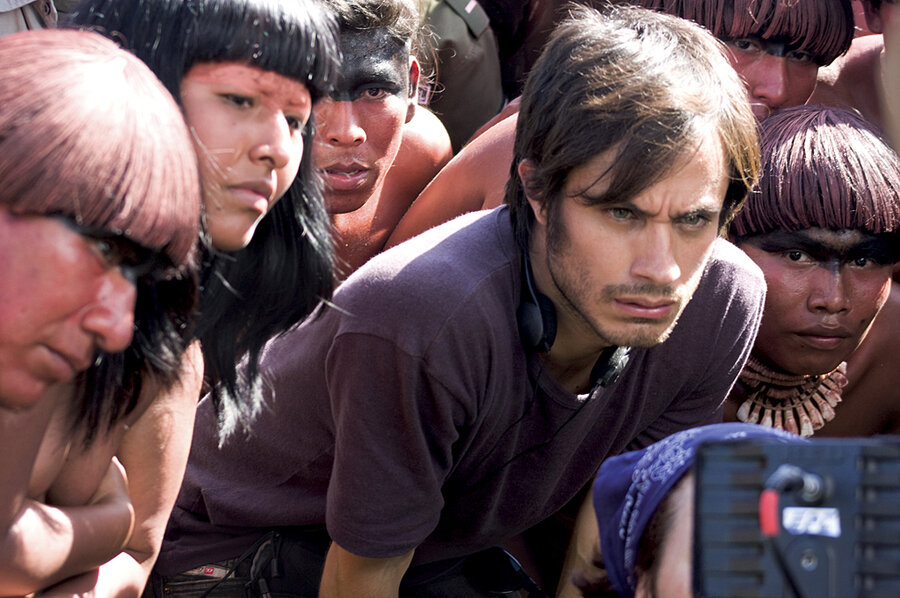Even the Rain: movie review
Loading...
In "Even the Rain," directed by Iciar Bollaín and written by Ken Loach's longtime screenwriter, Paul Laverty, a film crew arrives in Cochabamba, Bolivia, in 2000 to shoot a shoestring-budget epic about Columbus's arrival in the Americas. The idealistic director, Sebastián (Gael García Bernal), and his friend Costa (Luis Tosar), his gruff, penny-pinching producer, are revisionists: They want to show how Columbus, obsessed with gold, exploited the indigenous Indians and perpetuated the slave trade.
Since extras are dirt-cheap in Bolivia – $2 a day – Costa is pleased to be shooting on location there. But shortly into the filming a conflict breaks out that in some ways parallels the fictional drama. In what is known as the Bolivian Water War, which occurred for real in April 2000, thousands of locals rebel against the corporate privatization of the city's water supply by a consortium that includes an American multinational.
In other words, "Even the Rain" is essentially three movies in one: The staged reenactment of Columbus's expedition, the filming of that staged expedition, and the contemporary local uprising. It's a lot to bite off, especially since Bollaín's budget doesn't seem to be much larger than Sebastián's.
None of the three story lines is a standout. The reenactments are performed without preamble. Actors strut and fret their hour upon the stage – in this case, the jungle – as if they had been rehearsing with the locals for weeks. I realize this is a form of dramatic shorthand, but it would have been revelatory to see how the Indians reacted to rehearsal and stage direction. (Playacting is perhaps best suited to those whose lives are not so grimly real.)
Ultimately the filmmakers are not interested in the consequences of theatrics except as they relate to politics. Once the uprising kicks in, the local playing the Indian rebel leader becomes the real-life leader of the water war. Daniel (Juan Carlos Aduviri) risks sabotaging both the film project and his own life. With his strong, carved features, Daniel is meant to be a stand-in for all exploited Indians, then and now. When he tells Costa, "Some things are more important than your film," we are supposed to concur mightily.
There is an odd masochism at work here. We are, in effect, being reminded by the moviemakers that movies are a poor substitute for real life and real political action. And yet we are being told all this in... a movie. What the filmmakers are really saying is that movies are valuable only as political weapons in the fight against imperialist oppression. (The film is dedicated to the late Howard Zinn, author of "A People's History of the United States.") The contentiousness between Daniel, who is practically deified, and Costa, who is vilified until he sees the light, is a Marxist dialectic personified.
By ennobling and sentimentalizing the Indians, Bollaín and Laverty risk turning them into waxworks. The Bolivian ruling class is rendered in stark shades of unvarying villainy. The local political leader tells Costa, "If we give one inch, these Indians will drive us back to the Stone Age." (All that is missing is a moustache for him to twirl.) Did the filmmakers imagine we wouldn't sympathize with the suffering, parched Indians unless the deck was stacked sky-high against them?
There are, inevitably, a couple of riveting moments mixed in with the agitprop. In the strongest scene, Sebastián wants to reenact a moment in the Columbus story when the local women drown their babies rather than have them slaughtered by soldiers. The modern-day mothers, who cannot even conceive of drowning their babies, refuse to play the scene.
It is in sequences like these that the clash of cultures in "Even the Rain" transcends propagandizing and moves into the realm of art. What the filmmakers don't often recognize is that art and politics are not antithetical. A powerful scene like this is proof positive. Grade: B- (Unrated. In Spanish, with subtitles.)
-----
More Monitor movie reviews:





